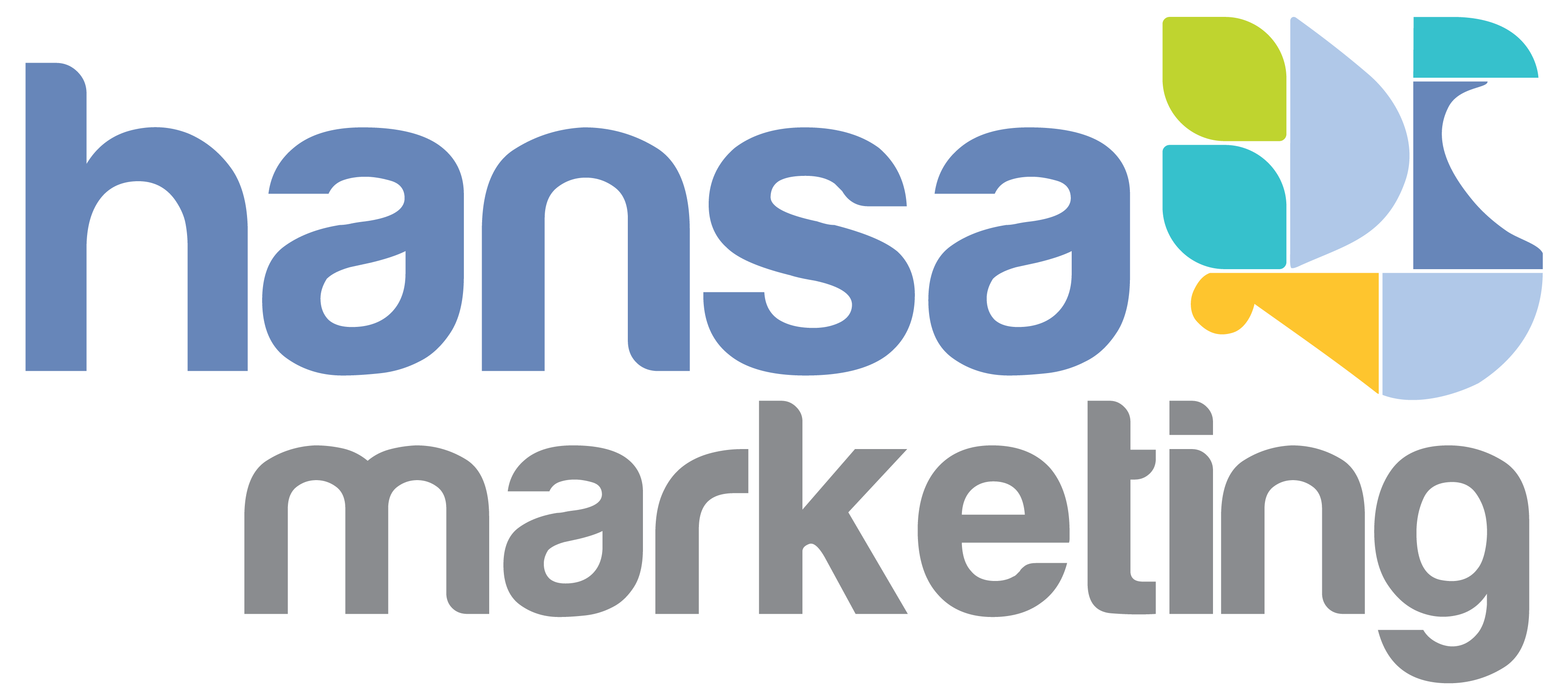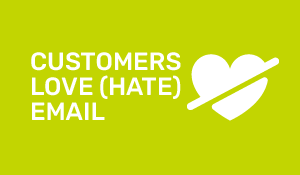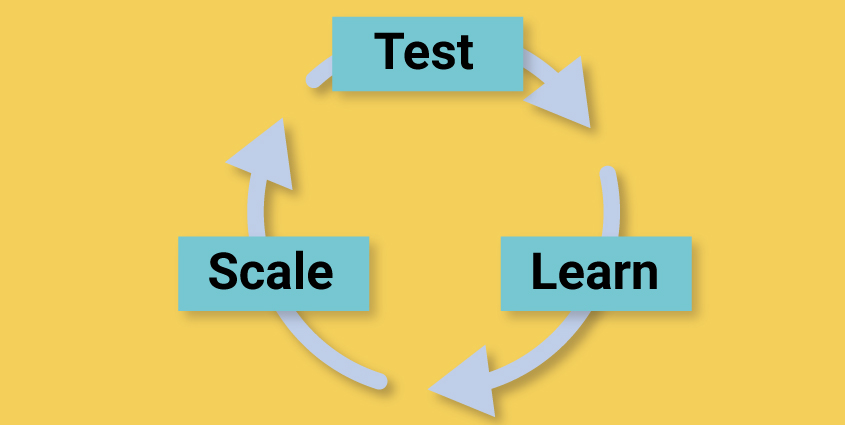Email is still the darling of digital when it comes to ROI: Email is low cost. By definition, email marketing is addressable media, so brands know immediately who is responding. In a survey, eConsultancy showed that brand managers feel email marketing is best at ROI, relative to other channels.
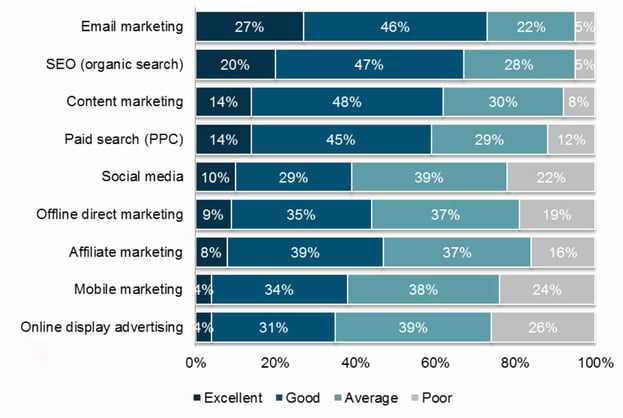
Problem is, every brand is in on this secret. Which explains the severe inbox clutter. On average, people get 300 emails per day, according to the Radicati Group. So how can brands stand out? If you were Nordstrom, what would you do to stand out? Clever subject lines?
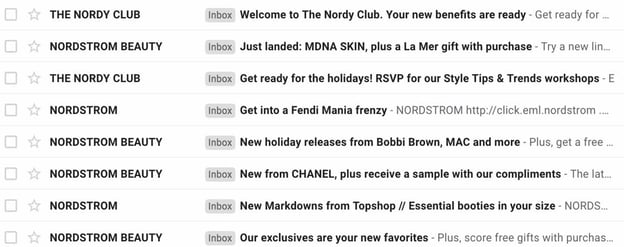
Hansa has been working on email marketing for decades. The most important thing we’ve learned is, it’s not the email, it’s the customer. To the customers who love this brand, this inbox looks like treasure. To customers who don’t, this very same inbox looks like junk. While it’s true email is easy to measure in terms of opens and clicks, our best practices guide will help you measure effectiveness, which goes beyond.
Defining email success beyond clicks
If we define success as opens and clicks, then the more we email, the more successful we appear. It’s hard to say no when there is a reward every time you hit send (i.e., Revenue) and it appears there is nothing wrong with emailing multiple times per day. Subscribers even come to expect the attention; the get trained on daily deals and sales incentives.
If you define success as short term performance, you will be challenged to continuously create email content and invest in operational resources for HTML coding, QA and deployment. This applies to Salesforce Marketing Cloud or any Marketing Automation tool.
Define email success as customer engagement
When brands expand their definition of success beyond opens and clicks, they measure customers, not clicks. Hansa has been compiling email best practices for years so when it comes to increasing customer engagement via email, consider these ideas.
- Segment the list. Not everyone in your database will engage with all your emails. Brands should evaluate how deep into the database to email. Some brands are skittish about emailing any subscriber that has not opened an email in a year. Other brands email everyone. This is a balancing act and the best email managers are testing different circulation tactics based on segmentation, including email, website and offline behaviors
- Personalize everything. Use data to empirically determine the best message, image, offer, subject line. Tools like Salesforce Interaction Studio can apply Artificial Intelligence (AI) to deliver personalized experiences at scale. The best practice is to develop a robust testing plan, then use the tools to optimize the choices. Test which Calls To Action (CTAs) compel behaviors. Determine which words, menus, images appeal to which segment and repeat the test based on device. Which versions inspire purchase? Which versions inspire shares and soft conversions?
- Respect channel preferences. Take advantage of other digital media and offline channels to continue to engage with customers who have opted out of email. Customers have channels of choice and a holistic communications plan should include paid media, social channels and offline as appropriate. Always offer ways to opt back into email and communicate value in doing so
Envision email as a conversation
We have worked with hundreds of email marketers over the years. Our best practices come from client successes. Our advice is to setup time-based workflows and define success as behaviors over time, not as “events” based on responses to individual email campaigns. How?
- Plan email in streams. Nordstrom sees its welcome stream as an opportunity to collect first-party data from new consumers. Of course there is an e-commerce aspect to these communications, but they set the stage for a long-term relationship based on the customer profile. In fact, the offer to join the Loyalty club is optimized to the perfect moment
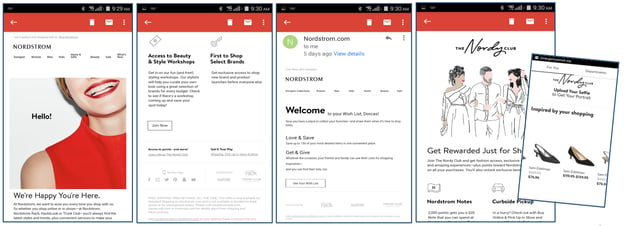
- Setup triggers. As customers engage in email and owned media (website, mobile), the best email programs detect behaviors then react. Research from Data Axle showed that trigger campaigns double open and clickthrough rates. A few best practices to keep in mind; trigger campaigns are smaller in scale and not meant to replace email blasts. Once a customer responds, they should be removed out of the general population then receive special attention. For larger enterprises, this means the tool has to govern which message shows up from which part of the business
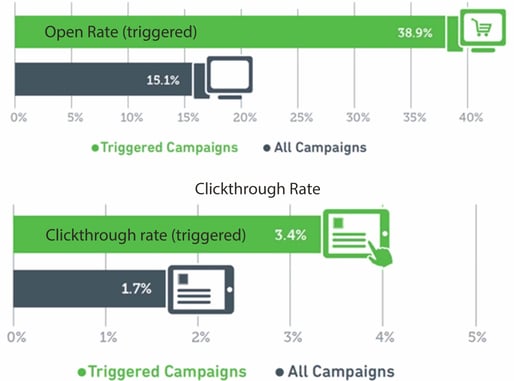
- Let customers control the conversation. Customers are in charge. They don’t see email as a channel; they see brand experiences that show up across channels. Each action should have an effect on the communication stream, individually. Sounds difficult but the best tools like Salesforce Journey Builder and Salesforce Interaction Studio can make this happen
- Tailor content to the journey. Can you determine where your customer is in their relationship with the brand? The best email marketers are constantly reinforcing the brand, but especially when a customer is new. This is the moment to suggest new varieties, upgrades, payment options. This is a perfect time to collect data and ask for product registration. As brands nurture a relationship, the object is to keep customers engaged with brand stories but also by selling attachment items and services. As time goes by, a brand should be intervening to mitigate cancellation or attrition
- Measure email longitudinally. The best Marketing leaders prove the value of email over time. They define success as business outcomes and include website behaviors after the clickthrough in their success measurement. These metrics happen over time. While it’s fun to see the effect of email measured in the hours after a send, it’s much more rewarding to demonstrate success over days, weeks and months of Marketing Communications
Metrics of email marketing
As a Marketing leader, it’s important to get the metrics of email right. Each metric has a job to do; each can help you evaluate success. But the best leaders don’t stop there. They push their email team, email agency and email tool to go beyond opens and clicks.
- Start with deliverability. Ensuring the quality and deliverability of email addresses should be every email manager’s priority. Hansa produces email report cards and uses services from firms such as TowerData. We check a representative sample of email addresses. And your team should be monitoring bounces by mailbox provider with every major send. Setup alerts and track deliverability over time as a benchmark
- Open and Clicks tell the story. Open rates will give Marketing leaders an early read on which email subject line is breaking through the clutter. The best tools allow multivariate testing and the ability to scale up winning ideas in real time. Clickthrough rates are the more important metric because it goes beyond interest and into action. Hansa’s best practice is to track these foundational metrics over time and establish benchmarks. But tracking what happens after the click is the key to success, and this can be Sales, Sales per Thousand, Average Spend, Number of Items, breadth of merchandise, added services, subscription sales, loyalty signups and so on. What are the key metrics for your business or client’s business?
- Conversion rate. Marketing leaders are measuring leading indicators of sales. This is especially important for two-step offers where a quote is required before the sale, and in B2B Marketing, when prospects fill out a form. It’s not always about e-commerce. And, as with all the metrics, these soft conversions should be tracked over time and benchmarked
- Keep an eye on opt outs. Every time you email a list of subscribers, you can expect opt outs. The best practice here is to manage this process holistically and develop ways for customers to manage communication preferences, instead of opting out entirely. These preference centers are must-haves for effective email marketing programs, and the best Marketers make it easy for customers to control the conversation with the brands they love
Measure customers not clicks
The best email marketers measure email beyond opens and clicks. They see email as generating business outcomes. At Hansa, our clients use metrics like:
- Engagement (on the website or with the brand in general)
- Shares and advocacy (forwarding the email, social interactions)
- Lifetime Value of the customer or account
- New versus returning subscribers
- Part of a group - a key account (in B2B) or active household (in B2C)
This is where dashboards measure the effectiveness of programs, not campaigns. Marketing leaders who are customer-centric see customers as email openers and clickers. We setup longitudinal analyses to gauge the number of touches and cumulative responses which can be eye opening. Sometimes this leads to some soul searching about reducing the amount of email. Read our blog on measuring email performance over time. But remember: it’s not the clever email that’s driving behavior, it’s the customer and their relationship with the brand
Leadership via email metrics
Measuring email is like watching TV – you want to watch together. Check out this funny commercial from Constant Contact:
“I thought we were going to look at the email metrics together”
When Marketing leaders share email results, they are really telling a story about brand and the value of Marketing. This brings everyone together. Email is both brand building and transactional. People look to Marketing leaders to elevate the metrics that matter. Which metrics matter to you? How will socialize what you learn?
Talk to one of our experts and we’re happy to share how we measure email effectiveness.
